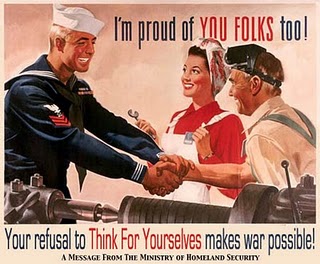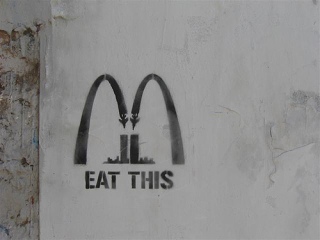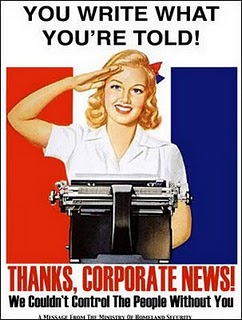One thing I liked about this paper is how angry it got me, by the end I was grinding my teeth about the concepts of censorship, propaganda and the overall whoring of the media. To start there are three major events that changed the way people were/are able to persuade the mass audience.
- Industrialization (the printing press, as one example)
- The emergence of mass media
- The emergence of mass democracies
 Louw’s paper read much like a narrative, taking you along the logical events of the past to the outrageous events of the present, but without getting to far off course, I will start with the past. The earliest form of war propaganda started with the American Civil War . Due to the higher kill rates thanks to new war machines a new machine needed to be built, a propaganda machine, this was used to encourage volunteers and re-supply the ranks. Then we move onto a more famous use of war propaganda, sparked by the England in 1914 (World War I.) Here not only was propaganda produced, but the mass media censored so as to provide more support to the propaganda. This was done through the negation of any negative news, the hype up of positive news and the arousal of patriotism through use of the narrative and heroes, another example I would like to add is demonizing the enemy (very important in relation to war propaganda), which was by far the greatest influence in recruiting, by making the fight a noble and just cause against an unspeakable tyrant. This propaganda model was not only effective in Britain, but in Germany as well, with the rise of World War 2 the Goebbel’s perfected propaganda machine was rolled out. (This is where I really got into it) Goebbel’s built his propaganda machine on the assumption that the masses were passive and mentally lazy, thus allowing the creation and imprinting of “truths” within the minds of the masses (this was mostly achieved through repetition, repetition, repetition.) Some of the major influences over the minds of the public were a new addition to the old build of the propaganda model and included (and see if you can think of a country who uses any of these techniques at present);
Louw’s paper read much like a narrative, taking you along the logical events of the past to the outrageous events of the present, but without getting to far off course, I will start with the past. The earliest form of war propaganda started with the American Civil War . Due to the higher kill rates thanks to new war machines a new machine needed to be built, a propaganda machine, this was used to encourage volunteers and re-supply the ranks. Then we move onto a more famous use of war propaganda, sparked by the England in 1914 (World War I.) Here not only was propaganda produced, but the mass media censored so as to provide more support to the propaganda. This was done through the negation of any negative news, the hype up of positive news and the arousal of patriotism through use of the narrative and heroes, another example I would like to add is demonizing the enemy (very important in relation to war propaganda), which was by far the greatest influence in recruiting, by making the fight a noble and just cause against an unspeakable tyrant. This propaganda model was not only effective in Britain, but in Germany as well, with the rise of World War 2 the Goebbel’s perfected propaganda machine was rolled out. (This is where I really got into it) Goebbel’s built his propaganda machine on the assumption that the masses were passive and mentally lazy, thus allowing the creation and imprinting of “truths” within the minds of the masses (this was mostly achieved through repetition, repetition, repetition.) Some of the major influences over the minds of the public were a new addition to the old build of the propaganda model and included (and see if you can think of a country who uses any of these techniques at present);
- Seemingly personal talks given by the party leader in question
- Representatives who are viewed with public favour (usually members of the public who spread positive thoughts about ‘said political leader’ while at public events – these were usually at parties, get togethers and so on and so forth)
- Utilizing film, radio and newspapers to reach the masses
- Moulding public opinion through emotive imagery, usually shown in newsreels
- Making new technology (wireless radio sets) cheaper (and more popular) so as the spread of information to the masses is easier to maintain (this became a nation building tool for Germany in World War 2)
In hindsight, if one were to overlook what Goebbels was working toward he could be thought of as a genius, the methods he used in his propaganda model were revolutionary and are used to this day. While I could dwell on the propaganda spread by U.S. and England at this point I am going to move right onto The Vietnam War where propaganda was revealed for the treacherous tool it is. That and Britain and the U.S. ended up basing their propaganda on the same methods as the Nazi’s, which I find a bit hypocritical.

Propaganda in
The Vietnam War was uncontrolled (if you consider there was any control to begin with), this failure to control the media led to one conclusion, that is the mass is not controlled the result is hegemonic disruption. The US military took this lesson to heart and learned to ‘public relations-ize warfare’ as Louw calls it, which he later nicknamed PR-ization warfare.
In 1982 America did a trial on PR-izing warfare with the Falklands War, here the media (usually one or two people) were transported with the military, in a sense they were
‘trapped’, so the military corralled the media and hence controlled it by creating a media blackout, so the only images coming back to the mainland were ones controlled by the government.
Then we have The Gulf War, where warfare became what Louw calls ‘Nintendo Warfare’ by excluding images of dead bodies, blood, brutality and gore and instead portraying war as a low risk with lots of tanks driving around and people patrolling and helping locals. The war was portrayed as ‘clean’ and almost devoid of suffering or death, in place of blood and dead bodies were ‘weapon counts’ and the destruction of inanimate objects, such as bridges and buildings. This then morphed into what I call the ‘Mario Complex’ where a victim is created that needs rescuing, like in Mario, this victim is helpless and the people fighting the war must overcome challenges and traverse terrain so as to be welcomed into the loving arms of the victim (more on this later.) So while all the blood and brutality of the Allied troops is ignored the brutality of the demonized enemy is portrayed in full, usually with the enemy/opposition displaying brutality towards the victim (hence why they need to be saved by America, uh, I mean, Mario)
Another example of Nintendo Warfare is the current War on Terror . Here we find pictures of happy civilians in Afghanistan, with the majority of images portraying the allied nations as a helping hand which was desperately needed, this then furthered with the recent capture and Execution of Saddam Hussein . The 2003 Iraq War was PR-ized as follows;
- Saddam Hussein was Demonized, reported as having weapons of mass destruction (WMD.) Reported as having links with al-Qaeda (even though al-Qaeda/Osama bin Laden were intensely hostile to Hussein’s secular regime. Spin Doctors persuaded the majority of Americans that Hussein was implicated in 9/11 attacks and that he was hoarding WMD
- War was justified by creating victims (Iraqi citizens) to be rescued from a villain (Saddam’s tyrannical regime.) On this point filtered repetition was used to enforce the point
- Nintendo war was portrayed

Taking a quick step back to the Gulf war, the media was still being controlled in the by deploying the ‘media liaison strategy’ (as in Falklands War) however the villain-victim model came under strain when the Iraqis failed to welcome their ‘US liberators’. After this Saddam’s statue was toppled (which was a very well PR event) and President Bush (prematurely) declared the war over. The main problems with the end result of this war, was that the truth was not hidden to the extent that it should of (assuming the US government wanted to maintain the hero persona.) Some examples of this (as well as the US spin) include;
- Lowering the burden of proof as to what constitutes a WMD find
- Creating plausible deniability (suggesting that Iraq destroyed the WMD before or during the war)
- Shifting the focus to the brutality and torture used by Saddam’s regime
- Suggesting that those that opposed US occupation were a minority which proved that Iraq should be treated cautiously in case there was a wider ‘war on terrorism’
- Bush administration PR lost control over the images coming out of Iraq
- 2004 images of US troops torturing Iraqis
 The later is an interesting case, when the images of torture emerged in 2004 concerning Abu Ghraib prison. Rather than defend their own people the American PR machine turned on them, portraying them as ‘rotten apples’ from a bad socio economic background, generally they were scapegoat-ed by the Bush administration so as to disassociate such negative images from any future war endeavours.
The later is an interesting case, when the images of torture emerged in 2004 concerning Abu Ghraib prison. Rather than defend their own people the American PR machine turned on them, portraying them as ‘rotten apples’ from a bad socio economic background, generally they were scapegoat-ed by the Bush administration so as to disassociate such negative images from any future war endeavours.
So what about peace? How is it sold to us? I don’t have as much to say about the selling of peace, just one thing, and it’s not really mine to say, but rather attributed to Winston Churchill, but of unknown origin; “History is written by the victors.” Where peace is the result of a hegemonic nation which has become established through war/conflict
Reference; Louw, P E 2005. ‘Selling War/Selling Peace’ ch. 10 in The Media and Political Process, Sage, Londond, pp. 210-235
*NOTE- The images that are a bit graphic are the only negative images I can find on the internet that reveal the war in Iraq in a negative light, such has been the tight control over image circulation. And I have been searching for the past 2 hours

 Propaganda in
Propaganda in 


 they can revert to an almost childish state, slinging verbal insults and acting in an uncouth matter not for any justifiable reason, but purely as an attention seeking joy ride.
they can revert to an almost childish state, slinging verbal insults and acting in an uncouth matter not for any justifiable reason, but purely as an attention seeking joy ride.